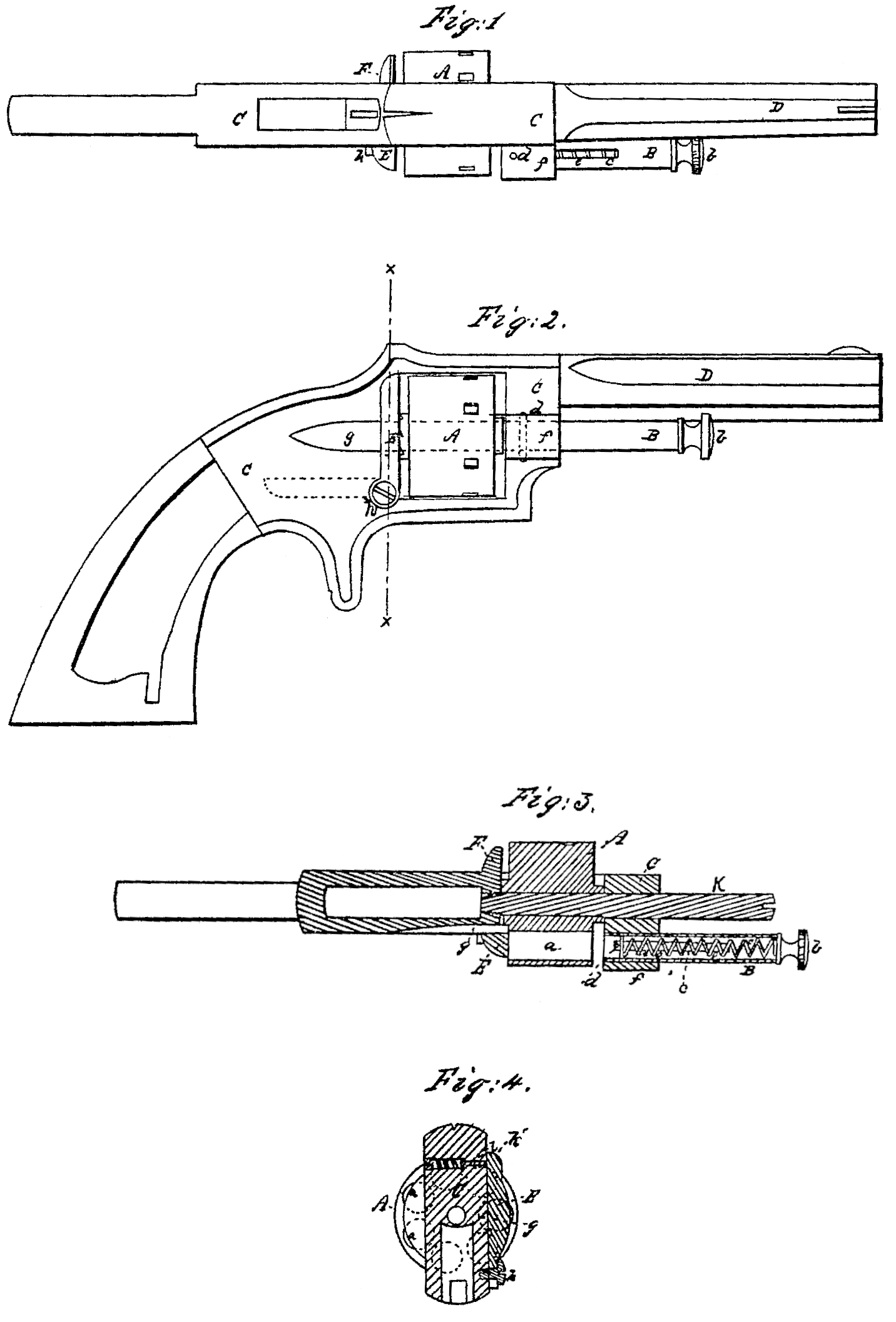US 63450
UNITED STATES PATENT OFFICE.
REUBEN W. DREW, OF LOWELL, MASSACHUSETTS,
Letters Patent No. 63,450, dated April 2, 1867.
IMPROVEMENT IN REVOLVING FIRE-ARMS.
The Schedule referred to in these Letters Patent and making part of the same.
TO ALL PERSONS TO WHOM THESE PRESENTS SHALL COME:
Be it known that I, REUBEN W. DREW, of Lowell, in the county of Middlesex, and State of Massachusetts, have invented a new and useful Improvement in Barrel-Loading Revolver Fire-Arms; and do hereby declare the same to be fully described in the following specification, and represented in the accompanying drawings, of which—
Figure 1 is a top view.
Figure 2, a side elevation; and
Figure 3, a horizontal section of a revolver breech-loading pistol, as provided with my invention.
Figure 4 is a transverse section taken on the line x x of fig. 2.
The purpose of my invention is an improvement upon the mode of retaining the cartridges in place in the rotary magazine preparatory to their being exploded, and afterward to enable a person to discharge from the rotary magazine of the pistol or fire-arm such cartridges, or the shells or spent cases thereof, by means of an improvement in the construction of the ejector; these devices being applied to those revolvers where the chambers are bored through from end to end of the cylinder, and loaded from the rear. To this end I arrange, in front of the rotary cylinder or magazine A, and with respect to the barrel D, as represented, a plunger or cartridge ejector, B, formed cylindrical, to fit either charge-chamber a of the said magazine. The axis of the said ejector B is disposed in line with the axis of one of the charge-chambers, extending beyond the side of the stock. Such ejector should be applied to the stock C of the fire-arm in such manner as to enable it (the ejector) to be moved longitudinally into and through any one of the charge-chambers of the magazine when such chamber may be brought around into line with the ejector. The ejecting of the shell by means of a piston moving in a stationary cylinder similarly placed is not new; but the construction and adaptation of my ejector differ therefrom, and are described as follows: In constructing such ejector I make it tubular, and with its outer end closed and provided with a head, b. I form in the said ejector a slot, c, extending down through it and lengthwise of it, and to within a short distance of its inner or open end; such slot being made to receive a pin; d, which is extended through the said slot and a projection, f, for supporting the ejector. A helical spring, e, is placed within the ejector, and bears at one end against the said pin, and at the other end against the head of the ejector. The said spring serves to retract the ejector from the magazine. The ejector is arranged aside of the screw-pink for supporting the magazine, and within the aforementioned projection f, which is extended from one side of the stock, the magazine being so far projected beyond such side of the stock as to bring the circumference of the circle of the axis of its charge-chambers in line with the axis of the ejector produced, Within the side of the stock, and in rear of the magazine or rotary cylinder A, I form a groove, g; and I apply to such side, and in rear of the magazine, a movable cartridge-guard, E, so formed as to nearly, if not wholly, cover the breech end of any charge-chamber of the magazine when such chamber may be in line with the ejector. The said guard is secured to the stock by, and turns on, a pin or screw, h, and is held up in place by a spring bolt, i, arranged in the stock, as shown in fig. 4; the guard having a bolt-receiving recess, k’, made in it, and of such form as to readily allow the guard being moved backward off the bolt by the finger of a person when applied to the guard. The groove g is to receive the flange of the cartridge shell, while such shell may be in the act of being either inserted in or driven from the cylinder, the groove causing the stock to present no impediment to the entrance of the cartridge into the cylinder or its expulsion therefrom. On the opposite side of the stock, and in rear of the rotary magazine, is a stationary guard, F, which projects from the stock, and serves to prevent any cartridge from dropping rearward out of its chamber of the magazine while such chamber Preparatory to the expulsion of a cartridge shell from the magazine by the ejector, the movable guard E should be turned down into, or nearly into, the position indicated by the dotted lines in fig. 2; that is, so as to uncover the rear end of the chamber from which the shell is to be expelled.
I have not represented in the drawings any mechanism for revolving the magazine; nor have I shown any portion of the percussion lock of the fire-arm, such mechanism and lock being matters foreign to my invention. With my said invention applied to a revolver breech-loading pistol or fire-arm there will be no necessity of removing the cylinder from the stock in order to effect either the charging of such cylinder or the expulsion from it of the cartridges or waste cases thereof, as circumstances may require.
Claim.
1. The tubular sliding ejector, constructed and operating in the manner described.
2. The arrangement of the hinged guard, with devices for fastening the same in place when constructed and attached to the stock or frame in relation to the perforated cylinder, all in the manner described.
REUBEN W. DREW
Witnesses:
R. H. Eddy,
F. P. Hale. Jr.

